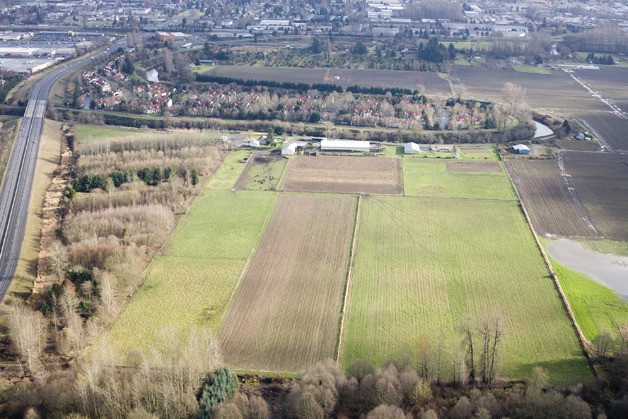It’s a tough go for new farmers in King County to buy farmland because of the high price.
Farmers have a hard time finding people willing to keep their operations going when the farmer retires or sells, so the land goes fallow.
“Many people aspire to be farmers but just can’t get on the land,” Bob Tidball, semi-retired owner of the 8-acre T&M Berry Farm in Auburn and a member of the King County Agricultural Commission, recently told the Auburn City Council.
Tidball was at City Hall to talk about the commission’s study on the future of agriculture in King County. Covering a 25-year period, the work examined trends, and the people who put it together interviewed farmers and surveyed partnering agencies and the public.
Despite persistent problems, the county has been making changes to its policies and regulations over the study period to enhance the viability of the industry, Tidball said, and those changes are having an effect.
A look back is instructive.
Once the Green River Valley was the world leader in hops production, the home of the northern baked potato, the nation’s leading producer of lettuce and cabbage and one of the preferred sources of strawberries for the major canneries. The Carnation line of dairy products started here, and Carnation, Borden and Libby all had processing plants in the valley.
Up to 60 years ago, about 150,000 acres in King County were in agriculture. But a rapid decline began in 1961 with the completion of the Howard Hanson Dam, allowing for the industrialization of the Green River Valley and the building boom of the 1960s and 1970s. Today, 42,000 acres in King County are designated as commercial agricultural land, mainly in five agricultural production districts (APDs). Each of these APDs has its own character of types and mixtures of farming activities.
As farmland disappeared, so did the number of farming operations, until about 1990 when the numbers began to increase. In 1987, there were 1,091 farms, and by 2,007 the number had increased to 1,790, a 64-percent increase over 20 years. Today’s typical farm is small, between 5 and 40 acres.
Today, the Lower Green APD consists of about 1,400 acres of prime soil, split into two separate areas, 75 percent in a Farmland Preservation Program, 52 percent farmer owned, 58 percent in row-crop production and 9 percent in livestock and dairy. But unlike the other APDs, the Lower Green is not seeing much of an increase in the number of small farms. Typically, a single large producer expands into the unused acreage.
Some farms are diversified, some focus on a specialty crop in a niche market, others integrate value-added processing into their operations. Many farms use direct marketing to increase profitability, and some use a new technique called community-supported agriculture, allowing the customer to buy a subscription up front to a share of the crop for the entire season.
According to the study, the value of agricultural production in King County rose from $66 million to $127 million annually, an increase of more than 92 percent over the study period. In terms of production ranking over the 39 counties in the entire state, King County advanced in that time from 17th to 13th. Only two counties in Western Washington, Skagit and Whatcom counties have a higher output.
Demand remains
Driving this growth, the study found, has been a dramatic increase in the public demand for locally grown food. Correspondingly, the number of farmers markets has increased from less than half a dozen to 41, with more startups advertising for managers and vendors. While a large part of the revenue increase has been livestock sales, the farmers’ markets are providing opportunities for vegetable and berry growers to expand.
Tidball noted the ties that still bind the cities to the agricultural lands.
“While cities have focused on urban growth for the last couple decades, they’re still connected to the agricultural community in various ways,” Tidball told the Council. “We grow some of your food. Hardly a month goes by that we don’t hear issues about food quality, food safety, security or energy. Growing food locally can address these issues,” he said. “The idea of fresh, locally grown food could explain the great public support that we’ve seen for farms. The organic idea is also really important in this.”
Tidball noted other connections, including farms that have incorporated recreation into their business models. A farm visit can provide a fun and healthy outdoor experience for families, he said, some of it highly educational for youngsters when they discover that not all foods come from grocery store shelves.
High costs
Still, challenges remain.
“While things have gone well the past decade and a half, we have to look at the flip side, because the agricultural community still faces some major problems. One persistent problem is farm succession. … And over time, land value increases and it becomes unaffordable to a new farmer. This is always particularly true in a growth area such as ours. Financing for farmlands has always been extremely difficult to get. Purchase of development rights and transfer of development rights programs have been used to alleviate the problems, and some have had moderate success. King County was one of the first in the nation to have a PDR program. It was approved by voters in 1979. But even with lands in these programs, values have escalated beyond the reach of most new farmers.
“… A local court once said that farming is suffering the death of a thousand cuts,” Tidball said. “That means that every little thing that takes away from the farmability of land, added together, is a big thing.”



